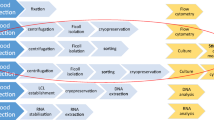Abstract
Analysis of the nucleoside triphosphate pyrophosphohydrolase specific activity of red cells obtained from a random Caucasian population indicated at least two subclasses. The specific activity of 18% of the population ranged from undetectable activity to 27.5 nmol ITP cleaved/20 min/mg hemoglobin. The remainder of the population had higher activity, 27.5–125 nmoles ITP cleaved/20 min/mg hemoglobin. The variation of NTPH activity evident in the red cells of an individual is reflected in granulocytes, lymphocytes, and platelets of that individual. Erythrocyte activity ranges from 0.7 to 21 units (nmol of ITP cleaved in 20 min)/107 cells, granulocytes have 17–201 units/107 cells, lymphocytes have 91–462 units/107 cells, and platelets have 1.1–7.1 units/107 platelets. These cell differences are discussed with respect to the hypothesis that NTPH prevents incorporation of ITP or dITP into nucleic acids.
Similar content being viewed by others
References
Austin, J. H., and Drabkin, D. L. (1935). Spectrophotometric studies. III. Methemoglobin. J. Biol. Chem. 11267.
Boyle, J. A., and Seegmiller, J. E. (1971). Preparation and processing of small samples of human material. Methods Enzymol. 22155.
Boyum, A. (1968). Isolation of leucocytes from human blood: Further observations. Scand. J. Clin. Lab. Invest. Suppl. 9731.
Chern, C. J., MacDonald, A. B., and Morris, A. J. (1969). Purification and properties of a nucleoside triphosphate pyrophosphohydrolase from red cells of the rabbit. J. Biol. Chem. 2445489.
Cutts, J. H. (1970). Cell Separation Methods in Hematology Academic Press, New York.
Diggs, L. W., Sturm, D., and Bell, A. (1975). The Morphology of Human Blood Cells 3rd ed., Abbott Laboratories, North Chicago, Ill.
Engle, R. L. (1960). The bone marrow. In Bruner, H. D. (ed.), Methods in Medical Research, Vol. 8, The Year Book Publishers, Chicago, p. 3.
Fraser, J. H., Meyers, H., Henderson, J. F., Brox, L. W., and McCoy, E. E. (1975). Individual variation in inosine triphosphate accumulation in human erythrocytes. Clin. Biochem. 8353.
Harris, H., and Hopkinson, D. A. (1976). Inosine triphosphate (ITP), In Handbook of Enzyme Electrophoresis in Human Genetics North-Holland, Amsterdam, p. 1.
Henderson, J. F., Zomber, G., Fraser, J. H., McCoy, E. E., Verhoef, V., and Morris, A. J. (1977). Factors affecting inosinate synthesis and inosine triphosphate accumulation in human erythrocytes. Can. J. Biochem. 55359.
Hershko, A., Jabotinsky, K., and Mager, J. (1969). Studies on red cell nucleoside triphosphate pyrophosphohydrolase. Isr. J. Med. Sci. 5991.
Karran, P., and Lindahl, T. (1978). Enzymatic excision of free hypoxanthine from polydeoxynucleotides and DNA containing deoxyinosine monophosphate residues. J. Biol. 2535877.
Lowry, O. H., Rosebrough, N. J., Farr, A. L., and Randall, R. J. (1951). Protein measurement with the Folin phenol reagent. J. Biol. Chem. 193265.
Rathbun, W. B., and Betlach, M. V. (1969). Estimation of enzymically produced orthophosphate in the presence of cysteine and the adenosine triphosphate. Anal. Biochem. 28436.
Soder, C., Henderson, J. F., Zombor, G., McCoy, E. E., Verhoef, V., and Morris, A. J. (1976). Relationships between nucleoside triphosphate pyrophosphohydrolase activity and inosine triphosphate accumulation in human erythrocytes. Can. J. Biochem. 54843.
Thomas, K. R., Ramos, P. M., and Olivera, B. M. (1978). Studies on the origin and structure of Okazaki pieces. In abstracts of the 42nd Cold Spring Harbor Symposium, DNA: Replication and Recombination Cold Spring Harbor Laboratory, Cold Spring Harbor, N.Y., p. 35.
Vanderheiden, B. S. (1969). Genetic studies of human erythrocyte inosine triphosphate. Biochem. Genet. 3289.
Vanderheiden, B. S. (1970). Biochim. Biophys. Acta 215555.
Vanderheiden, B. S. (1975). ITP pyrophosphohydrolase and IDP phosphohydrolase in rat liver. J. Cell Physiol. 86167.
Wang, J. K., and Morris, A. J. (1974). The distribution of nucleoside triphosphate pyrophosphohydrolase in the tissues of the rabbit. Arch. Biochem. Biophys. 161118.
Author information
Authors and Affiliations
Additional information
This work was supported by funds allocated by the Agricultural Experiment Station, Michigan State University. Michigan Agricultural Experiment Station Journal No. 8727.
Rights and permissions
About this article
Cite this article
Verhoef, V.L., Fuller, S.A. & Morris, A.J. Individual variation of nucleoside triphosphate pyrophosphohydrolase activity in human erythrocytes, granulocytes, lymphocytes, and platelets. Biochem Genet 18, 235–245 (1980). https://doi.org/10.1007/BF00484239
Received:
Revised:
Issue Date:
DOI: https://doi.org/10.1007/BF00484239




